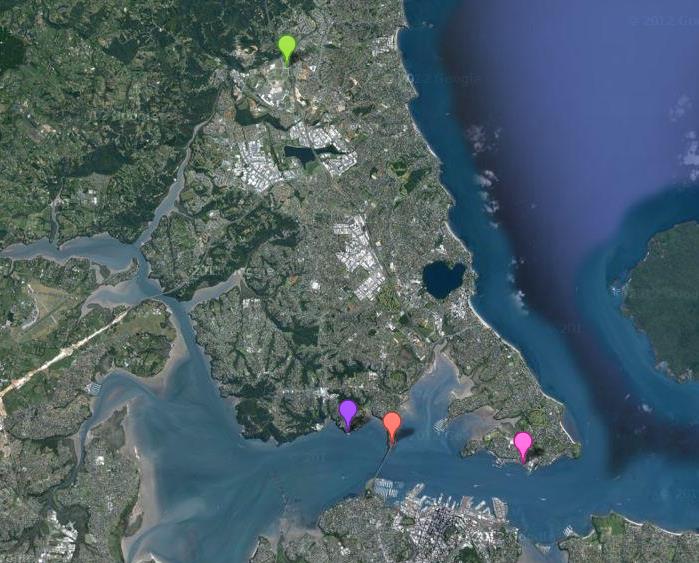link to page 8




 EFFECTIVENESS OF T2 PARKING FOR THE BUSWAY AND WHARVES IN NORTH
SHORE
Keenan Lim
EFFECTIVENESS OF T2 PARKING FOR THE BUSWAY AND WHARVES IN NORTH
SHORE
Keenan Lim
Department of Civil and Environmental Engineering
University of Auckland, Auckland, New Zealand
Abstract
This research looks at the Effectiveness of the T2 parking for the Bus way and Wharves in North Shore. The main
objective of this research is to determine the understanding of drivers on T2 parking and the level of compliance of
drivers with the T2 parking. From the interviews results which reflect the thinking and behaviour of the parking users,
more than 80% of them are familiar with the T2 parking and the awareness of its location in the respective is also high.
The five carpooling factors are time, convenience, location, people factor and cost. In Albany, the main factor for
carpooling is cost whereas in Devonport and Birkenhead, people factor becomes major. People only consider carpooling
if their schedule is adjusted by no more than 20 minutes. The main factor for non-carpooling in all three sites is
inconvenience. More than 60% of the non-carpooling users are willing to consider share ride give that their problems
for being unable to carpool are ideally solved. A few recommendations are suggested to be implied on the existing car
parks which include expansion of T2 spaces, providing parking vacancy indicator, penalty fine and rearrangement of
car park. Overall, all the T2 parking are fully utilised and effective for carpooling which can promote the use of public
transport.
1. Introduction
strategies introduced and one of them was the promotion
of public transport. As a strategy to increase public
transport usage, Auckland Transport implemented the
'T2 Parking’. T2 parking is a preferential parking for
high
occupant
vehicles
which
provides
'more
Albany Park
convenient/closer' parking to encourage carpooling
& Ride
during morning peak. The T2 Parking provision applies
Station
from midnight to 9:30am. This research is to study the
effectiveness of the T2 parking at the Albany Park and
Ride station, Devonport Wharf and Birkenhead Wharf
in North Shore, Auckland. This report only considers
the results and feedback based on the parking users from
the three parking sites.
Birkenhead
Wharf
Devonpor
Auckland
t Wharf
2. Literature Review
Harbour
2.1. Preferential Parking Implementation
Bridge
Parking problems are quite significant in almost every
Figure 1: Location of the three parking sites with
major city in New Zealand and internationally. It is well
Auckland Harbour Bridge as reference point
known that the limited parking availability will lead to
several issues such as roadway congestion, air pollution
Traffic congestion has become a major concern to
and driver frustration. As strategies to solving
worldwide particularly in major cities. Parking in
transportation and traffic congestion problems, vehicles
Auckland central city is geographically constrained. To
trips have to be reduced for more efficient use of
counteract with the problem there were a number of
transportation resources
(Dorsey, 2005). The strategy
link to page 8 link to page 8 link to page 8 link to page 8 link to page 8 link to page 8 link to page 8 link to page 8 link to page 8 link to page 8 link to page 8 link to page 8 link to page 8 link to page 8 link to page 8
include shirting solo drivers to carpool or transit,
patronage on the bus service has developed a constant
allowing more employees to work at home, or adjusting
growth
(NSCC, 2010).
work schedules to avoid peak period auto travel
(Giuliano and Wachs, 1992).
With the increasing usage of park and ride facilities at
the Albany Bus way Station, Devonport ferry wharf and
Park and ride gains its popularity after it became a
Birkenhead ferry wharf, the North Shore City Council
means for the suburban as well as city’s residents to
(NSCC) has trialed a scheme which recommends the a
gain access to public transport such as bus and ferry
methodology for preferential parking that aims to fully
services
(Wang et al., Sept 2004). Another strategy is to
utilize the car parks available and to get more
provide high occupancy vehicles (HOVs) with an
passengers on ferries and buses. Preferential parking for
advantage over small occupancy vehicles (SOVs) on
about 68 HOVs with two or more people will be
congested roadways… Preferential parking has been a
introduced at the Albany Park ‘n Ride Bus way and 28
suggestion that will probably increase the passenger
HOV carpool parks at the Devonport wharf for weekday
usage of the park and ride areas thereby improving
commuters
(AKTNZ, 2010). The offer of preferential
parking efficiencies and hence increasing patronage on
parking is intended as an incentive for commuters to
buses and ferries
(Anthony, 2004).
find a passenger for their car, or to become a passenger
in another car by travelling with someone else
(NSCC,
2010). This will have the effect of achieving a higher
2.2. International
Experience
with
Preferential
level of passenger patronage on the related public
Parking for HOV
transport service, yet without increasing the present
The majority of international references to HOVs put
parking spaces or inducing any other additional traffic
them in the context where they were seen as a means of
movements in the area. A trial of preferential parking at
undertaking the whole journey as an alternative to or
these two sites can be carried out, with appropriate
substitutes for a bus or single occupant car trip.
education
and
marketing,
signage,
and
finally
Therefore, the majority of references to preferential
enforcement. The recommended trail would allow the
parking for HOVs focused on municipal parking in a
number of spaces reserved for HOVs to be increased or
town center, or on travel planning for individual
decreased depending on demand and uptake
(AKTNZ,
workplace sites. However, there doesn’t appear to be a
2010). The key factors in the trials include the limited
great deal of international experience of specifically
supply of park and ride spaces at these locations,
encouraging HOVs as a means of travelling to a park
research indicating HOVs could form in these areas and
and ride facility
(NSCC, 2010).
access to regular high quality passenger transport
(NSCC, 2010)
HOVs were generally seen as a means of undertaking
the whole journey as an alternative to or substitute for a
The criteria that qualified a vehicle as a complying
bus or car trip. Up to date, only a few instances of
participant in this scheme is that the vehicle arrives
providing preferential parking for HOVs at park and
carrying at two people and parks for a certain amount of
ride facilities were found in web search. There were all
time whether a short of long term. Thus legitimate users
in North America, two in California; one in Florida and
of the scheme were both those drivers who arrive
one in Canada. Each of these was at a fairly low scale
together with the required number of people in the car
and two were trial projects. The majority of these trials
who all dismount and use the public transport service
required drivers to register either their vehicles or
(long term parking), and kiss-and-ride vehicles (short
themselves and their passengers, and to display passes
term parking), again with required at least two people
on their vehicles when parked in the preferential
in the car on arrival
(NSCC, 2010). This criteria
parking spaces
(NSCC, 2010).
simplified recognition of qualifying vehicles, as trying
to distinguish between short or long term parkers is not
There was also some evidence showing that Australia
possible from direct observation of the vehicle at any
entry ‘check point’’ prior to the vehicle becoming
implemented the trial. Minister for transport, Mr. Cox
was asked by the Sydney City Council to introduce a
stationary in the car park and its occupants dismounting.
trial preferential parking scheme for residents in the
Some HOVs have been seen to arrive and park, one
south Paddington area
(October 26, 1976).
passenger departs to use a public transport service,
while the other sits in the car and reads for a while
before catching a later service. This is complying
2.3. Preferential Parking Trial in North Shore
behavior
(NSCC, 2010).
The idea of preferential carpool parking only arrived in
Likewise use of the scheme by car poolers at Devonport
New Zealand in the early 2010. Since the Northern
(who then travel off the site) is complying provided the
Express bus service was introduced with the opening of
car that remains parked was a complying HOV. Since
the Albany and Constellation Bus way stations in 2005,
link to page 8 link to page 8 link to page 8 link to page 8

the use of the scheme by car poolers is likely to be
survey came to a halt and the remaining vacancies were
minimal this use is not considered to be detrimental. If it
recorded
(Chu, 2012).
proves a popular use, however, then it may be that
some parking spaces at the more remote end of the
parking area could be allocated for that purpose, distinct
3.2. Direct Interviews
from the preferential parking intended to serve the
Interview questionnaires regarding the awareness as
public transport activity
(NSCC, 2010).
well as the compliance with the T2 parking were
conducted after the traffic survey. However permission
The Albany site is limited for use by bus patrons only
from the Ethic Approval was needed before any
and that over-riding requirement will remain for all
interview could commence.
parks in the Albany Bus way Station Park and ride car
park. Observations of kiss-and-ride behavior at Albany
and Devonport find that there are seldom more than two
3.3. Data Analysis
kiss-and-ride vehicles discharging at any time in any
case, and so this mode does not represent any ‘threat’ to
Extra demand and the non-compliance of the
the scheme’s main emphasis of providing longer term
T2 parking were determined based on the
parking for HOVs
(NSCC, 2010).
traffic surveys count
Data form the interviews on parking users were
The criteria refers only to arriving vehicles because
analysed to examined their knowledge and
experience and observation confirms that in many cases
thinking behaviour on the T2 parking
a group of people who have contrived to carpool for the
Recommendations and improvements were to be
journey to work have different travel demands for the
suggested on the existing car park
homeward journey. Thus the departing vehicle may in
many instances carry fewer than the qualifying number
of people. This effect does not detract from the
preferential parking scheme’s objectives, as it is
4. Results and Analysis
believed that the returning passengers frequently utilize
The following displays the data from the interviews
public transport from the station/ terminal to complete
which reflect the thinking and behaviour parking users
their return journey
(NSCC, 2010).
from Albany Bus Station and wharves in Devonport and
Birkenhead. 100 interviews were commenced for the
Albany Bus Station while 50 interviews each for
Devonport and Birkenhead wharves. These interviewers
3. Methodology
came from random selection.
3.1. Traffic survey
Early morning surveys were conducted at each of the
bus station and wharves from 6:30am till 9:30am. The
4.1. Knowledge of T2 parking
surveys ran for two days per week (Thursday and
Fridays). Two persons conducted the survey and to
ensure higher efficiency and accuracy and each survey
In Figure 1, the blue bar shows the percentage of the
was separated into two parts:
a) One measured the occupancy of the car park:
Proportion of Parking Users Knowing
Number of arriving and leaving
and Aware of T2 Parking
vehicles were recorded
Number of passengers (including the
100%
driver himself) were recorded
80%
b) The other measured the compliance of the T2
e
g
parking users:
60%
Knowing T2
Whether users were using it at the
centa
Parking
40%
right manner
existence
Per
Number of dropping off vehicles were
20%
recorded
0%
Awareness of
T2 Parking
Once the T2 spaces had been filled, the time was
location
recorded and any high occupant vehicles that entered the
car park would be counted as extra demand. In case
where the T2 parking did not get full by 9:30am, the
Figure 2: People knowing and aware of T2 parking
parking users that know the meaning of T2 parking
Figure 2 shows the percentage of parking users that are
whereas the red bar shows the percentage of people
encouraged to carpool by the T2 parking provision. The
from the blue bar that are aware of the T2 parking
parking
site
in
Devonport
has
the
highest
location in the respective car park. In Albany, 84% of
encouragement, which is 77% of the parking users are
the parking users know the meaning of T2 parking
motivated to carpool, followed by Albany, 43% and
whereas 88% for Devonport and 82% for Birkenhead.
finally Birkenhead, 34%.
Overall, more than 80% of the parking users are
familiar with the T2 parking provision with minority
Figure 3 shows the percentage of parking users that are
being unfamiliar with it.
actually carpooling. With highest percentage of
carpoolers in Birkenhead, 29%, Albany comes second
with 21% and finally Devonport with 16%.
4.2. T2 parking consideration
4.3. Carpooling factors
T2 encourages Carpooling
There are five main factors that contribute to carpooling:
Time – required time for a complete to and fro
Albany
Devonport
Birkenhead
journey
Convenience – accessibility of a journey
without any major time constraint
Location – location of the pickup (carpool
Birkenhead
34%
partner) results change in ordinary travelled
path
People factor – availability of a carpool partner
Cost – savings in terms of travelled cost
Devonport
77%
Albany
43%
Figure 3: Encouragement of T2 parking
Parking Users that Carpool
Albany
Devonport
Birkenhead
Birkenhead
29%
Devonport
16%
Albany
21%
Figure 4: Proportion of people that carpool





 4.3.1.
Reasons to carpool
4.3.2.
Reasons not to carpool
Major reason in Albany
Major reason in Albany
4.3.1.
Reasons to carpool
4.3.2.
Reasons not to carpool
Major reason in Albany
Major reason in Albany
Time
Cost
Time
Cost
Convenience
People factor
Convenience
People Factor
Location
Location
11% 11%
36%
27%
59%
5%
51%
Figure 5: Major carpooling reason in Albany
Figure 7: Major non-carpooling reason in Albany
Major reason in Devonport
Major reason in Devonport
Time
Cost
Time
Cost
Convenience
People factor
Convenience
People factor
Location
Location
10% 15%
33%
17%
67%
58%
Figure5: Major carpooling reason in Devonport
Figure 8: Major non-carpooling reason in Devonport
Major reason in Birkenhead
Major reason in Birkenhead
Time
Cost
Time
Cost
Convenience
People factor
Convenience
People factor
Location
Location
36%
15% 10%
18%
57%
7%
57%
Figure 6: Major carpooling reasons in Birkenhead
Figure 9: Major non-carpooling reason in Birkenhead
In Albany, the cost factor takes up the main factor
4.5. Suitable Parking
which is shown as the blue section in the pie chart
Table 2: Frequency of getting suitable parking spot
whereas people factor becomes the major in both
Devonport and Birkenhead.
Frequently get good
The inconvenience factor is the main reasons for people
Parking Site
parking spot
being unable to carpool in all the three parking sites,
followed by unable to find a carpool partner which is the
Albany (after
people factor.
42% (91%)
extension)
4.4. Carpooling frequency and effect on daily
Devonport
81%
schedule
Table 1:Carpooling frequency and effect
Birkenhead
90%
Parking Site
Albany
Devonport
Birkenhead
The results in table 2 only display the feedback from
Carpool for
non-carpooling users as it is based on analysing the ease
five days in a
83%
86%
75%
of parking users find a non T2 parking spot. There was a
week
significant change in percentage in the Albany after the
car park extension, i.e. from 42% to 91%.
Delay due to
carpool is less
4.6. Non car poolers willing to share ride given
78%
86%
83%
than 15
opportunity
minutes
Non carpoolers willing to carpool given
opportunity
The table shows how often people share rides on
89%
weekday’s basis and their daily schedule adjustment in
86%
order to carpool.
63%
83% of the car poolers in Albany share ride for five
days in a week whereas 86% in Devonport and 75% in
Birkenhead. On average more than 81% of them
perform carpooling from Mondays to Fridays.
The majority of the parking users only consider
carpooling if the impact of delay to their daily schedule
is no more than 15 minutes. In Albany, 78% of the car
Albany
Devonport
Birkenhead
poolers have delay less than 15 minutes while 86% and
83% in Devonport and Birkenhead respective.
Figure 6: Non carpool users to car poolers
The chart displays the percentage of non-carpooling
parking users who are willing to share ride given any of
these opportunities:
No time constraint
Very convenient
Carpool partner within close distance
Someone is willing to share ride
Substantial savings in travelling costs
In general, at least 63% of the non-carpooling users are
willing to consider sharing ride if their problems are
ideally solved.
link to page 8 link to page 8
In the Traffic Survey Counts, the percentage of HOVs is
9%, 22%, and 32% in Albany, Devonport, and
4.7. Albany Car Park (after extension)
Birkenhead respectively
(Chu, 2012).
Table 3: Recommendations on Albany car park after
extension
5.3. Carpooling Factors and Impact
In order to increase carpooling, it is crucial to learn the
Increase T2 parking
68%
factors that are driving people to do so. The five major
factors are time, convenience, location, people factor
Mobility parking to T2 parking
38%
and cost.
As residential area is distant from the Albany Bus
Station, travelling to the station cab be quite costly and
therefore the cost becomes the major factor for people to
The above recommendations were suggested to the
carpool. Unlike in Devonport and Birkenhead wharves
Albany car park after the extension. Majority of the
people factor takes the highest percentage because both
parking users agree to have an extension of the T2
wharves only target their nearby respective residential
spaces. Though the mobility parking never get full
area.
utilized, based on the feedback from the interviewers,
the mobility parking should be left untouched.
The reasons behind the non-carpooling users are
important as well. It is known that sharing ride can be
very inconvenient as the ride sharing parties will have to
5. Discussion
adjust their daily schedule accordingly to their
respective carpool partner. As a support to this
5.1. Knowledge on T2 parking
statement, most people would only consider carpooling
Overall, the majority of the parking users in all the three
if the delay is less than 15 minutes.
parking sites are familiar and the awareness of its
location in the respective car park is very high.
However, there are still a small proportion of people
5.4. Carpool frequency
who do not know the meaning the T2 parking. This may
In table 1, at least 75% of the car poolers do carpool for
due to the fact the implementation of T2 parking
five days in a week which means that these people have
provision only happened in 2010 which was two year
permanent work and daily activities. While they are
ago. In addition, parking users were more familiar with
relying on the public transport, they cannot afford any
the term ‘carpool parking’ instead of ‘T2 parking’. It is
major delay to their schedule which will results in
believed that as time proceeds, T2 parking will gain
missing the public transport and disruption to the work
higher popularity in the future.
and activities.
5.2. Encouragement on Carpooling and Carpooling
5.5. Frequency of getting suitable parking
Percentage
From Table 2, it is shown that the chance of people
In Figure 2 and Figure 3, there is a difference between
getting a good parking spot had been doubled after the
the percentage of T2 parking encouraging people to
extension of the car park in Albany which results in the
carpool and the people who are really carpooling. This
capacity of the car park has exceeded the demand of the
means some of the parking users realise the benefits of
parking users
(Chu, 2012).
T2 parking but some factors are restricting them from
doing so.
In comparison between the car parks of Devonport and
Birkenhead, Devonport parking site is located in the
These data were based loosely on random parking users
form of cluster whereas Birkenhead car park is located
and people thinking. The proportion of people that
along the street with side angle parking. Therefore,
carpool should not be used for further studies as it is just
people will often find it more difficult to determine the
a comparison between encouragement of T2 on
remaining vacancy of the parking in Devonport
carpooling and percentage of people that carpool. The
compared to Birkenhead, i.e. 81% and 90% in
actual proportion of carpooling users should be based on
Devonport and Birkenhead respectively.
Traffic Survey Count.
link to page 8 link to page 8
5.6. Non carpooling users to carpooling users
7. Conclusion
From Traffic Survey Counts, the percentage of HOVs is
In general majority of the parking users have knowledge
91%, 78%, and 68% in Albany, Devonport, and
on the T2 parking indicating that T2 parking has high
Birkenhead respectively
(Chu, 2012). In Figure 6, the
popularity. This research has proven that the T2 parking
non-carpooling users who are willing to consider
provisions are effective for carpooling and can promote
carpooling are 89%, 63% and 86% in Albany,
the use of public transport in Auckland. Potential for
Devonport and Birkenhead respectively. This results in
improvement is available for further considerable
81%, 49%, and 59% of improvements in the three car
extension of T2 parking utilisation.
parks restively. In overall, there will be a possibility that
the carpooling activities will increase by at least half its
original value.
Acknowledgements
I would like to thank the supervisor Assoc. Prof Roger
Dunn, Auckland Transport, and other transportation
5.7. Recommendations to Albany car park after
authorities and organisations for providing the support
extension
and contribution to make this project successful
Majority of the interviews agreed that the T2 spaces
should be expanded as prior to the extension of the
whole car park, the non T2 parking were limited but
8. References
after the extension the capacity far exceeded the
demand. In addition the time when the T2 parking is full
.
is rather early, between 8:00am and 8:30am, an
October 26, 1976. Move for Resident Parking.
The
indication that there is extra demand for T2 parking
Sydney Morning Herald.
(Chu, 2012).
AKTNZ, A. T. A. U. D. 2010. Available:
http://www.aktnz.co.nz/2010/08/10/nth-shore-
As the mobility parking never been fully utilised, a
gets-car-pool-trial/.
suggestion was made which was to convert some of the
ANTHONY, D. 2004.
Still Stuck in traffic: Coping with
mobility parking to T2 parking. Only minority of the
Peak-Hour Traffic Congestion, Brookings
interviewers provided positive feedback while the
Institution Press.
majority thought that they should be reserved as a
CHU, J. Y. S. 2012. Effectiveness of T2 parking for the
privilege for someone who needs it.
busway and wharves in North Shore.
DORSEY, B. 2005. Mass transit trends and the role of
unlinited access in transportation demand
6. Recommendations and Improvements
management.
Journal of Transport Geography,
Expansion of T2 parking
13
, 235 - 246.
Provide indication of the remaining parking
GIULIANO, G. & WACHS, M. 1992. Transportation
vacancy
Demand Management as Part of Growth
Develop a strategy to help non-carpooling
Management.
The Planning Challenge of The
users who are willing to carpool
1990s.
Consider re-arrangement of car park to provide
NSCC, N. S. C. C. 2010. Meeting of Infrastsucture and
better and more convenient parking
Environment Commitee.
Continue monitoring the changes and demands
WANG, J. Y. T., YING, H. & R, L. Sept 2004.
Locating
of the existing car parks.
and Pricing Park-and-Ride Facilities in a
linear monocentric city with deterministic
mode choice.











